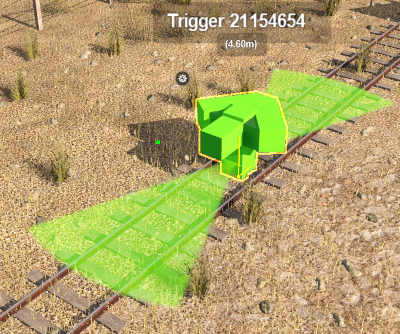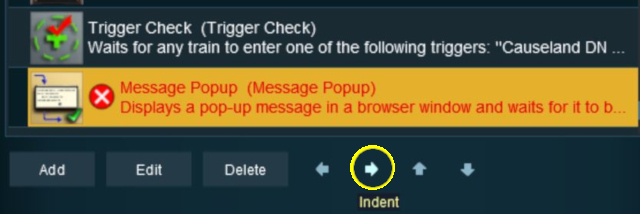How to Use Track Triggers
(Updated to include S2.0 Filter Palette) |
m |
||
| (2 intermediate revisions by one user not shown) | |||
| Line 294: | Line 294: | ||
<table width=1000> | <table width=1000> | ||
<tr valign="middle"> | <tr valign="middle"> | ||
| − | <td width=400>[[image:TrackMarkRadiusTools.png|link=]]</td> | + | <td width=400>[[image:TrackMarkRadiusTools.png|link=]]<br> |
| + | <table bgcolor=#000000 cellpadding=2> | ||
| + | <tr valign="top"> | ||
| + | <td> | ||
| + | <table bgcolor=#ffffb0 cellpadding=2> | ||
| + | <tr valign="top"> | ||
| + | <td width=25>[[image:NotePad.PNG|link=]]</td> | ||
| + | <td>Other track objects that have a '''Trigger Effect Radius''' include '''Track Markers''', '''Track Direction Markers''', '''Track Priority Markers''' and '''Whistle Signs'''. In some cases the visible "effect wings" are red instead of green.</td> | ||
| + | </tr> | ||
| + | </table> | ||
| + | </td> | ||
| + | </tr> | ||
| + | </table> | ||
| + | </td> | ||
<td> | <td> | ||
<table width=600 bgcolor=#000000 cellpadding=2> | <table width=600 bgcolor=#000000 cellpadding=2> | ||
| Line 442: | Line 455: | ||
[[image:DotPoint1.JPG|link=]] In the '''Filter Palette''' either:- | [[image:DotPoint1.JPG|link=]] In the '''Filter Palette''' either:- | ||
<table width=1100> | <table width=1100> | ||
| + | <tr valign="top"> | ||
| + | <td> | ||
| + | <table width=790> | ||
<tr valign="top"> | <tr valign="top"> | ||
<td> | <td> | ||
| Line 460: | Line 476: | ||
Then select '''Track Objects'''<br> | Then select '''Track Objects'''<br> | ||
[[image:FilterSelectTrackObjects_S20.png|link=]] | [[image:FilterSelectTrackObjects_S20.png|link=]] | ||
| + | </td> | ||
| + | </tr> | ||
| + | </table> | ||
| + | </td> | ||
| + | </tr> | ||
| + | <tr valign="top"> | ||
| + | <td colspan=3> | ||
| + | <table bgcolor=#000000 cellpadding=2> | ||
| + | <tr valign="top"> | ||
| + | <td> | ||
| + | <table bgcolor=#ffffe0 cellpadding=2> | ||
| + | <tr valign="top"> | ||
| + | <td colspan=2>[[image:PencilTips.PNG|link=]] <span style="font-size: 15px; font-weight: 700; color: white; background-color: blue;"> Shortcut </span> If you already have a '''Trigger''' placed in your route then:-</td> | ||
| + | </tr> | ||
| + | <tr valign="top"> | ||
| + | <td width=20>[[image:DotPoint1Blue.png|link=]]</td> | ||
| + | <td>move the tool pointer over the existing trigger object and hold down the <span style="font-weight: 700; font-size: 15px; color: white; background-color: black;"> Alt </span> key. The object name will appear in a '''ToolTip''' attached to the pointer</td> | ||
| + | </tr> | ||
| + | <tr valign="top"> | ||
| + | <td>[[image:DotPoint2Blue.png|link=]]</td> | ||
| + | <td>while holding down the <span style="font-weight: 700; font-size: 15px; color: white; background-color: black;"> Alt </span> key <span style="font-weight: 700; font-size: 15px; background-color: lightcyan;">Left Click</span> on the trigger to identify it in the '''Assets Palette''' and to select the '''Placement Tool'''. Release the key.</td> | ||
| + | </tr> | ||
| + | <tr valign="top"> | ||
| + | <td colspan=2>Jump to '''Step [[image:DotPoint5.JPG|link=]]''' below.</td> | ||
| + | </tr> | ||
| + | </table> | ||
| + | </td> | ||
| + | </tr> | ||
| + | </table> | ||
</td> | </td> | ||
</tr> | </tr> | ||
| Line 518: | Line 563: | ||
</table> | </table> | ||
</td> | </td> | ||
| − | |||
| − | |||
| − | |||
| − | |||
| − | |||
| − | |||
| − | |||
| − | |||
| − | |||
| − | |||
| − | |||
| − | |||
| − | |||
| − | |||
| − | |||
| − | |||
| − | |||
| − | |||
| − | |||
| − | |||
| − | |||
| − | |||
| − | |||
| − | |||
</tr> | </tr> | ||
</table> | </table> | ||
| Line 748: | Line 769: | ||
</table> | </table> | ||
</td> | </td> | ||
| + | </tr> | ||
| + | </table> | ||
| + | </td> | ||
| + | </tr> | ||
| + | </table> | ||
| + | <br> | ||
| + | <table bgcolor=#000000 cellpadding=2> | ||
| + | <tr valign="top"> | ||
| + | <td> | ||
| + | <table bgcolor=#ffffb0 cellpadding=2> | ||
| + | <tr valign="top"> | ||
| + | <td width=25>[[image:NotePad.PNG|link=]]</td> | ||
| + | <td>Other track objects that have a '''Trigger Effect Radius''' include '''Track Markers''', '''Track Direction Markers''', '''Track Priority Markers''' and '''Whistle Signs'''. In some cases the visible "effect wings" are red instead of green.</td> | ||
</tr> | </tr> | ||
</table> | </table> | ||
| Line 1,146: | Line 1,180: | ||
<tr valign="top"> | <tr valign="top"> | ||
<td width=25>[[image:DotPoint6Blue.png|link=]]</td> | <td width=25>[[image:DotPoint6Blue.png|link=]]</td> | ||
| − | <td><span style="font-weight: 700; font-size: 15px; background-color: lightcyan;">Left Click</span> on the '''''<span style="text-decoration: underline;">Add | + | <td><span style="font-weight: 700; font-size: 15px; background-color: lightcyan;">Left Click</span> on the '''''<span style="text-decoration: underline;">Add Trigger</span>''''' link</td> |
</tr> | </tr> | ||
<tr valign="top"> | <tr valign="top"> | ||
Latest revision as of 07:04, 10 December 2024
The information in this Wiki Page applies to TANE, TRS19, Trainz Plus and TRS22.
|
|
[edit] What are Track Triggers? |
| Track triggers can be programmed to respond when a train (any train or a specific train) passes over them in Driver Mode. The response comes from executing a set of Session Rules that have been attached to a |
||||||||
Shown below left is a standard Trigger and below right is a Directional Trigger. They are just two examples of several types of track triggers. In both cases:-
|
||||||||
|
||||||||
[edit] Route or Session? |
| Triggers can be placed in a Route Layer or in a Session Layer |
|
 |
Information on Route and Session layers can be found at:- |
[edit] Adding a Trigger |
|
[edit] In Surveyor Classic (S10) |
[edit] Adding a Trigger (S10)
 |
|
|||||||||||||||
| As soon as a new trigger has been placed, its properties window will open on the screen. It will initially be given a default name and assigned to the currently active layer. |
[edit] Set the Trigger Name and Layer (S10)
 |
|
[edit] Set the Effect Radius (S10)
At the bottom of the Track Tools flyout menu is an Advanced button. Left Click this button to open the advanced tools.
| The Effect Radius sets the size of green "effect wings" attached both ends of the Trigger. This sets how close a consist has to approach to trigger its "event". The smaller the radius the closer it must approach. |

|
|
||||||||||||||||||||||||||||||||||||||||||
|
[edit] In Surveyor 2.0 (S20) |
|
[edit] Adding a Trigger (S20)
In the Filter Palette either:-
|
|
||||||||||||||||||||||||||||||||||||
In the Assets Palette to narrow down the filter list, type "trigger" (UPPER/lower case does not matter) in the Search Text Box
 Both pallets shown docked |
|
Place the Trigger on the track.
 |
|
|||||||||||||||||||||||
|
|||||||||
[edit] Change Its Name (S20)
The name of the Trigger IS important. It is needed to identify the Trigger in Session Rules.
 |
|
|||||||
[edit] Set its Effect Radius (S20)
| The Effect Radius sets the size of green "effect wings" attached both ends of the Trigger. This sets how close a consist has to approach to trigger its "event". The smaller the radius the closer it must approach. |
 |
|
||||||||||
[edit] Move a Trigger Along the Track (S20)
Triggers can be moved along the track or to other tracks.
 |
|
|||||
[edit] Move the Trigger Vertically (S20)
| Triggers can be physically placed above (or below) the track. This feature allows them to be placed, for example, above the track so that they will not be hidden in Surveyor if a consist is parked on the Trigger. |
 |
|
|||||||||||||||||||
[edit] Move the Trigger Horizontally (S20)
| Triggers can be physically placed left or right alongside the track. This feature allows them to be placed, for example, beside the track so that they will not be hidden in Surveyor if a consist is parked on the Trigger. |
 |
|
|||||||||||||||||||||
|
[edit] Assign a Trigger to a New Layer (S20)
| The Info Palette will show the layer assigned to the currently selected object. To the left of the layer name is a small arrowhead object. | |||||||||||||||||||||||
  |
|
||||||||||||||||||||||
[edit] Creating a Trigger Event |
| When a consist enters the Effect Radius of a Trigger it will create an "event" that can be detected and responded to by some Session Rules and some Driver Commands. One such rule is the Trigger Check Rule which is added to a Session in the |
 |
More information on the Trigger Check Rule can be found on the Trainz Wiki Rules Page at:- |
| Steps: | |||||||||
Open the Session Editor:
|
|||||||||
| Add the Trigger Check Rule: | ||||||||||
|
|
 |
 |
This will add the Trigger Check rule to the session. |
|
Open the Trigger Check Rule Properties:
|
|||||
Configure the Rule:
|
|||||||||||
| Select the Trigger: The Trigger Selection Window will open and list all the Triggers in your Route.
|
|||||||||
[edit] Adding an Instruction to the Trigger Event |
[edit] Adding a Child Rule
To test your trigger event you will need to add some Session Rules.
| Steps: | ||||||||||||||
Add A Message Popup Rule:
|
||||||||||||||
Indent the Popup Message Rule:
|
|||||||||
[edit] Configuring the Message and Testing |
| Steps: | |||||
Open the Message Popup Rule for Editing:
|
|||||
|
|
|||||||||||||||||||||||
| Left Click on the |
The completed Message Popup Rule |
 |
More information on this rule can be found on the Trainz Wiki Page at:- |
|
Another example of using the Trigger Check Rule can be found in the Trainz Wiki Page How to Use Message Popup Rule (Applications).
[edit] Alternatives to the Trigger Check Rule |
 |
There are other Session Rules that can be used in place of the Trigger Check Rule and Triggers. A few possibilities are listed below:-
|
 |
There is a driver command that can be used in place of the Trigger Check Rule:-
|
[edit] Trainz Wiki
|
|
This page was created by Trainz user pware in May 2018 and was last updated as shown below.















